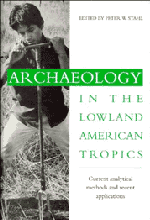Book contents
- Frontmatter
- Contents
- List of figures
- List of tables
- List of contributors
- Introduction
- 1 Archaeological survey and site discovery in the forested neotropics
- 2 The archaeology of community organization in the tropical lowlands: a case study from Puerto Rico
- 3 Archaeological methods for the study of ancient landscapes of the Llanos de Mojos in the Bolivian Amazon
- 4 Searching for environmental stress: climatic and anthropogenic influences on the landscape of Colombia
- 5 “Doing” paleoethnobotany in the tropical lowlands: adaptation and innovation in methodology
- 6 Plant microfossils and their application in the New World tropics
- 7 Differential preservation histories affecting the mammalian zooarchaeological record from the forested neotropical lowlands
- 8 Biological research with archaeologically recovered human remains from Ecuador: methodological issues
- 9 Interpreting dietary maize from bone stable isotopes in the American tropics: the state of the art
- 10 From potsherds to pots: a first step in constructing cultural context from tropical forest archaeology
- 11 Returning to Pueblo Viejo: history and archaeology of the Chachi (Ecuador)
- References
- Index
6 - Plant microfossils and their application in the New World tropics
Published online by Cambridge University Press: 23 November 2009
- Frontmatter
- Contents
- List of figures
- List of tables
- List of contributors
- Introduction
- 1 Archaeological survey and site discovery in the forested neotropics
- 2 The archaeology of community organization in the tropical lowlands: a case study from Puerto Rico
- 3 Archaeological methods for the study of ancient landscapes of the Llanos de Mojos in the Bolivian Amazon
- 4 Searching for environmental stress: climatic and anthropogenic influences on the landscape of Colombia
- 5 “Doing” paleoethnobotany in the tropical lowlands: adaptation and innovation in methodology
- 6 Plant microfossils and their application in the New World tropics
- 7 Differential preservation histories affecting the mammalian zooarchaeological record from the forested neotropical lowlands
- 8 Biological research with archaeologically recovered human remains from Ecuador: methodological issues
- 9 Interpreting dietary maize from bone stable isotopes in the American tropics: the state of the art
- 10 From potsherds to pots: a first step in constructing cultural context from tropical forest archaeology
- 11 Returning to Pueblo Viejo: history and archaeology of the Chachi (Ecuador)
- References
- Index
Summary
The Neotropics are home to over 50,000 species of plants, which have existed together in their modern geographic assortments since shortly after the end of the Pleistocene, 11,000 years ago. Various lines of evidence, including modern plant distributions, accounts of the first Europeans to see tropical America, and the archaeological record from deserts occupying tropical latitudes, tell us that many species were domesticated or manipulated extensively in prehistory (for example, Oviedo 1959; Plowman 1984; Ugent et al. 1986). In addition, ethnobotanical studies provide a living testament to the impressive knowledge of plants held by native tropical people (for example, Duke 1968; Posey and Bailee 1989; Prance and Kallunki 1984).
However, these many affiliated lines of evidence stand in contrast to the limited data on prehistoric plant exploitation accumulated from archaeological sites. The lowland humid tropics, by definition, encompass a set of environments that are inimical to the preservation of organic material. Year-around high temperature and humidity, or fluctuating rainy and dry periods in regions with marked seasonality, ensure that the recovery of plant remains from archaeological sites presents formidable challenges to prehistoric researchers.
Donald Lathrap's brilliant insights into native tropical society included prominent attention to the ways in which culture and the plant world articulate (Lathrap 1970, 1973).
- Type
- Chapter
- Information
- Archaeology in the Lowland American TropicsCurrent Analytical Methods and Applications, pp. 130 - 153Publisher: Cambridge University PressPrint publication year: 1995
- 10
- Cited by

